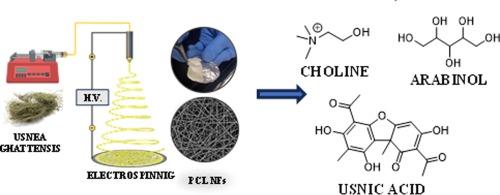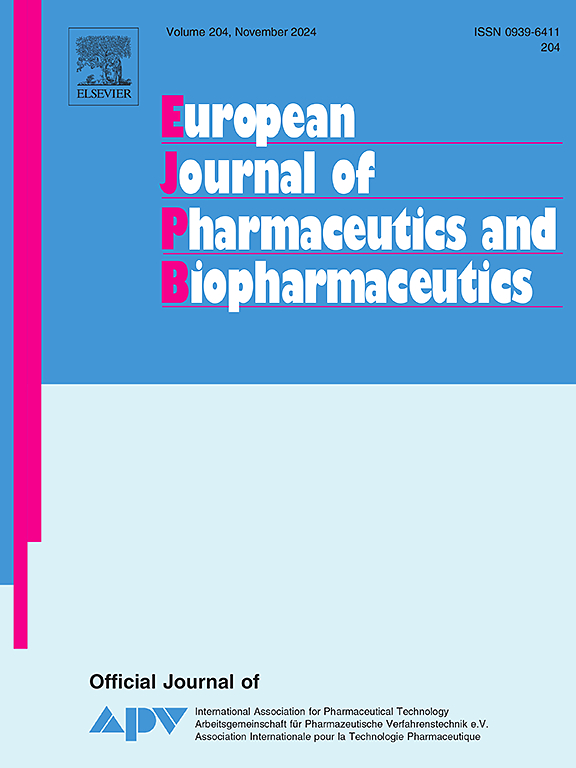用于局部释放具有神经保护作用的 USNEA ghattensis 天然提取物的电纺纳米纤维。
IF 4.4
2区 医学
Q1 PHARMACOLOGY & PHARMACY
European Journal of Pharmaceutics and Biopharmaceutics
Pub Date : 2024-10-28
DOI:10.1016/j.ejpb.2024.114552
引用次数: 0
摘要
本研究的基础是将乌蛇床子的甲醇提取物加入聚己内酯(PCL)纳米纤维(NFs)中,研究其减少活性氧(ROS)的能力。研究人员采用电纺丝技术制备了 PCL-NFs 并将其作为一种潜在的敷料材料进行了研究,该材料主要用于释放鼠李酸(PCL-USNIC NFs),并通过高效液相色谱法(HPLC)分析了其封装效率和释放动力学。这项研究是通过分析烟酸浓度与垫中心点距离的函数关系来进行的。此外,还对麝香草提取物(PCL-USNEA NFs)进行了动力学释放分析,通过核磁共振(NMR)对释放分子随时间变化的代谢组学分析。结果表明,鸟苷酸是最相关的化合物,其他分子如蔗糖、甘露醇、阿拉伯糖醇或甘油也对鸟苷酸的释放产生积极的基质效应。最后,我们利用人类神经母细胞瘤细胞系模型分析了 PCL-USNEA 和 PCL-USNIC NFs 的细胞毒性和神经保护作用。结果表明,这两种聚合物系统的毒性都很低,在高氧化环境(如 H2O2)下具有很强的保护作用。本文章由计算机程序翻译,如有差异,请以英文原文为准。

Electrospun nanofibers for localized drug release of a neuroprotective natural extract of Usnea ghattensis
This research is based on the incorporation of the methanolic extract of the Usnea ghattensis into poly (caprolactone) (PCL) nanofibers (NFs) to investigate the capacity in reducing reactive oxygen species (ROS). PCL-NFs were fabricated by the electrospinning technique and are investigated as potential dressing material focused on the release of usnic acid (PCL-USNIC NFs), and its encapsulation efficiency and kinetic release were analyzed by high performance liquid chromatography (HPLC). This investigation was performed by analyzing the usnic acid concentration as a function of the distance from the mat center point. The kinetic release analysis is also developed with the usnea ghattensis extract (PCL-USNEA NFs), performing a metabolomic analysis of the released molecules as a function of time by nuclear magnetic resonance (NMR). Usnic acid was revealed as the most relevant compound together with other molecules, such as sucrose, mannitol, arabitol or glycerol that generate a positive matrix effect on the release of usnic acid. Finally, we analize the cytotoxicity and the neuroprotective effect of PCL-USNEA and PCL-USNIC NFs using a human neuroblastoma cell line model. Negligible toxicity was appreciated for both polymeric systems, showing high protective effects in presence of highly oxidative environment (e.g. in presence of H2O2).
求助全文
通过发布文献求助,成功后即可免费获取论文全文。
去求助
来源期刊
CiteScore
8.80
自引率
4.10%
发文量
211
审稿时长
36 days
期刊介绍:
The European Journal of Pharmaceutics and Biopharmaceutics provides a medium for the publication of novel, innovative and hypothesis-driven research from the areas of Pharmaceutics and Biopharmaceutics.
Topics covered include for example:
Design and development of drug delivery systems for pharmaceuticals and biopharmaceuticals (small molecules, proteins, nucleic acids)
Aspects of manufacturing process design
Biomedical aspects of drug product design
Strategies and formulations for controlled drug transport across biological barriers
Physicochemical aspects of drug product development
Novel excipients for drug product design
Drug delivery and controlled release systems for systemic and local applications
Nanomaterials for therapeutic and diagnostic purposes
Advanced therapy medicinal products
Medical devices supporting a distinct pharmacological effect.

 求助内容:
求助内容: 应助结果提醒方式:
应助结果提醒方式:


